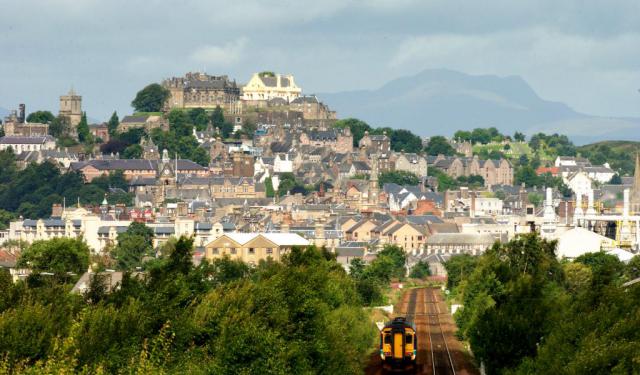
Outer Defenses of Stirling Castle, Stirling
The Outer Defenses of Stirling Castle represent a complex system of artillery fortifications, largely developed in their current form during the 18th century. However, older elements, such as the French Spur on the east side, date back to the mid-16th century under the regency of Mary of Guise. The French Spur, originally an orillon (an ear-shaped bastion), featured gun emplacements to defend the main spur. This structure was fortified with a talus, and an earth ramp, and was accessible via a drawbridge over a defensive ditch. Excavations in the 1970s revealed that significant portions of the original stonework still exist beneath the later modifications.
In response to the Jacobite threat in 1708, enhancements to the castle's defenses became a priority. The military engineer Theodore Dury proposed a new defense plan, but this was met with criticism from Captain Obryan, who offered a more costly alternative. A compromise was ultimately implemented, and the new defenses were completed by 1714. These changes included the extension of the main front wall to create Guardhouse Square, which established a double line of defensive walls, both protected by ditches and caponiers (covered firing galleries). One of these caponiers remains accessible today via a narrow staircase from Guardhouse Square.
To bolster the defenses, casemates (chambers built behind the walls) were constructed, allowing for additional gun emplacements. Modifications to the French Spur permitted the installation of more cannons. Guardhouse Square itself was further developed in the 19th century, and just outside the castle lies the early 19th-century Esplanade, which was originally a parade ground and is now used for parking and public performances.
In response to the Jacobite threat in 1708, enhancements to the castle's defenses became a priority. The military engineer Theodore Dury proposed a new defense plan, but this was met with criticism from Captain Obryan, who offered a more costly alternative. A compromise was ultimately implemented, and the new defenses were completed by 1714. These changes included the extension of the main front wall to create Guardhouse Square, which established a double line of defensive walls, both protected by ditches and caponiers (covered firing galleries). One of these caponiers remains accessible today via a narrow staircase from Guardhouse Square.
To bolster the defenses, casemates (chambers built behind the walls) were constructed, allowing for additional gun emplacements. Modifications to the French Spur permitted the installation of more cannons. Guardhouse Square itself was further developed in the 19th century, and just outside the castle lies the early 19th-century Esplanade, which was originally a parade ground and is now used for parking and public performances.
Want to visit this sight? Check out these Self-Guided Walking Tours in Stirling. Alternatively, you can download the mobile app "GPSmyCity: Walks in 1K+ Cities" from Apple App Store or Google Play Store. The app turns your mobile device to a personal tour guide and it works offline, so no data plan is needed when traveling abroad.
Outer Defenses of Stirling Castle on Map
Sight Name: Outer Defenses of Stirling Castle
Sight Location: Stirling, Scotland (See walking tours in Stirling)
Sight Type: Attraction/Landmark
Guide(s) Containing This Sight:
Sight Location: Stirling, Scotland (See walking tours in Stirling)
Sight Type: Attraction/Landmark
Guide(s) Containing This Sight:
Walking Tours in Stirling, Scotland
Create Your Own Walk in Stirling
Creating your own self-guided walk in Stirling is easy and fun. Choose the city attractions that you want to see and a walk route map will be created just for you. You can even set your hotel as the start point of the walk.
Stirling Castle Walking Tour
Sitting atop Castle Hill in Stirling, Stirling Castle is one of the largest and most important castles in Scotland, both historically and architecturally. Before the union with England, the Castle was also one of the most used of the numerous Scottish royal residences, acting as both a palace and a fortress. Several Scottish kings and queens have been crowned at Stirling, including Mary, Queen of... view more
Tour Duration: 1 Hour(s)
Travel Distance: 0.8 Km or 0.5 Miles
Tour Duration: 1 Hour(s)
Travel Distance: 0.8 Km or 0.5 Miles
Stirling Introduction Walking Tour
On the River Forth in central Scotland, you'll find the picturesque city of Stirling. Its location at the lowest crossing point over the river made it a strategic spot to start a settlement. The town dates back to ancient Roman times, though much of the city is medieval and Victorian. It was a small market town that grew while becoming known as the "Gateway to the Highlands."
... view more
Tour Duration: 2 Hour(s)
Travel Distance: 2.3 Km or 1.4 Miles
... view more
Tour Duration: 2 Hour(s)
Travel Distance: 2.3 Km or 1.4 Miles


